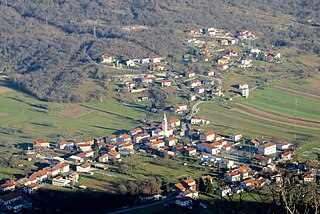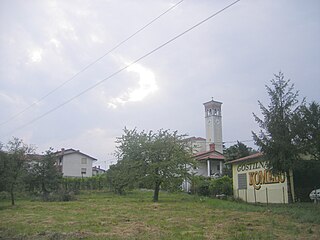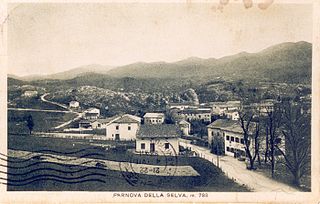Banjšice | |
|---|---|
| Coordinates: 46°3′10.64″N13°42′40.87″E / 46.0529556°N 13.7113528°E Coordinates: 46°3′10.64″N13°42′40.87″E / 46.0529556°N 13.7113528°E | |
| Country | |
| Traditional region | Slovenian Littoral |
| Statistical region | Gorizia |
| Municipality | Nova Gorica |
| Area | |
| • Total | 14.45 km2 (5.58 sq mi) |
| Elevation | 670.9 m (2,201.1 ft) |
| Population (2002) | |
| • Total | 264 |
| [1] | |
Banjšice (pronounced [ˈbaːnʃitsɛ] ; Italian : Bainsizza or Bainsizza Santo Spirito) is a settlement in western Slovenia in the Municipality of Nova Gorica. It has a population of 264. It is located on the high Banjšice Plateau, overlooking the Soča Valley. It is made up of several hamlets, including Breg, Lohke, Ošlakarji, Mrcinje, Trušnje, Podlešče, Raven, Kuščarji, and Krvavec. [2]

Italian is a Romance language of the Indo-European language family. Italian, together with Sardinian, is by most measures the closest language to Vulgar Latin of the Romance languages. Italian is an official language in Italy, Switzerland, San Marino and Vatican City. It has an official minority status in western Istria. It formerly had official status in Albania, Malta, Monaco, Montenegro (Kotor) and Greece, and is generally understood in Corsica and Savoie. It also used to be an official language in the former Italian East Africa and Italian North Africa, where it plays a significant role in various sectors. Italian is also spoken by large expatriate communities in the Americas and Australia. In spite of not existing any Italian community in their respective national territories and of not being spoken at any level, Italian is included de jure, but not de facto, between the recognized minority languages of Bosnia-Herzegovina and Romania. Many speakers of Italian are native bilinguals of both standardized Italian and other regional languages.

Slovenia, officially the Republic of Slovenia, is a sovereign state located in southern Central Europe at a crossroads of important European cultural and trade routes. It is bordered by Italy to the west, Austria to the north, Hungary to the northeast, Croatia to the southeast, and the Adriatic Sea to the southwest. It covers 20,273 square kilometers (7,827 sq mi) and has a population of 2.07 million. One of the successor states of the former Yugoslavia, Slovenia is a parliamentary republic and a member of the United Nations, of the European Union, and of NATO. The capital and largest city is Ljubljana.

Nova Gorica is a town and a municipality in western Slovenia, on the border with Italy. Nova Gorica is a planned town, built according to the principles of modernist architecture after 1947, when the Paris Peace Treaty established a new border between Yugoslavia and Italy, leaving nearby Gorizia outside the borders of Yugoslavia and thus cutting off the Soča Valley, the Vipava Valley, the Gorizia Hills and the northwestern Karst Plateau from their traditional regional urban centre. Since 1948, Nova Gorica has replaced Gorizia as the principal urban centre of the Goriška or Gorizia region, as the northern part of the Slovenian Littoral has been traditionally called.
The parish church in the settlement is dedicated to the Holy Spirit and belongs to the Diocese of Koper. [3]
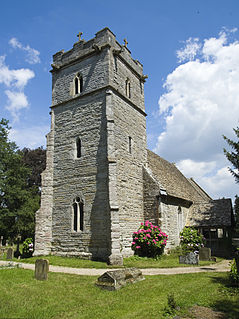
A parish church in Christianity is the church which acts as the religious centre of a parish. In many parts of the world, especially in rural areas, the parish church may play a significant role in community activities, often allowing its premises to be used for non-religious community events. The church building reflects this status, and there is considerable variety in the size and style of parish churches. Many villages in Europe have churches that date back to the Middle Ages, but all periods of architecture are represented.
Holy Spirit is a term found in English translations of the Bible that is understood differently among the Abrahamic religions. The term is also used to describe aspects of other religions and belief structures.
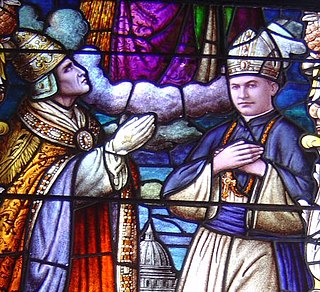
The word diocese is derived from the Greek term dioikesis (διοίκησις) meaning "administration". Today, when used in an ecclesiastical sense, it refers to the ecclesiastical district under the jurisdiction of a bishop.



